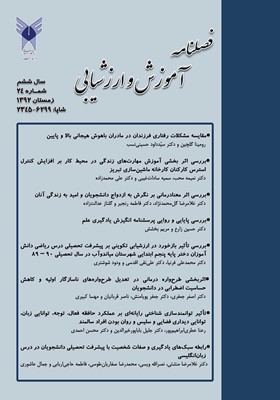بررسی پایایی و روایی پرسشنامه انگیزش یادگیری علم
محورهای موضوعی : روانشناسی تربیتی
1 - عضو هیئت علمی دانشگاه پیام نور
2 - دانشگاه پیام نور مرکز ملایر، گروه علوم تربیتی، همدان، ایران، نویسنده مسئول.
کلید واژه:
چکیده مقاله :
به منظور بررسی پایایی و روایی پرسشنامۀ انگیزش یادگیری علم، نمونه ای متشکل از 258 زن و 117 مردِ 17 تا 24 ساله (میانگین سنی 22 سال) از دانشجویان پیام نور مرکز ملایر، پرسشنامۀ مذکور را تکمیل نمودند. بررسی همسانی درونی پرسشنامۀ نشان داد که تمام 35 گزارة این مقیاس با نمرة کل همبستگی بالایی داشتند. مقدار پایایی پرسشنامه از طریق محاسبۀ ضرایب آلفای کرونباخ و پایایی گاتمن، برای کل مقیاس به ترتیب 838/0 و 875/0 به دست آمد. همچنین، در بازآزمایی پرسشنامه با فاصلۀ زمانی 2 هفته، ضریب همبستگی 667/0 به دست آمد که در سطح 001/0 معنی دار بود. جهت بررسی روایی محتوا، تعدادی از استادان روان شناسی، قابلیت پرسشنامه را در سنجش انگیزش یادگیری علم تأیید کردند. تحلیل عاملی اکتشافی، برای بررسی روایی درونی به استخراج 6 عامل، منطبق با خرده مقیاس های این پرسشنامه منجر شد که در مجموع 05/56 درصد از واریانس کل را تبیین کردند. همچنین، آلفای کرونباخ از 728/0 تا 847/0 و میانگین همبستگی از 092/0 تا 477/0 برای خرده مقیاس ها، نشان دهنده پایایی درونیوروایی تشخیصیپرسشنامه بود. یافته های پژوهش نشان دادند که پرسشنامۀ انگیزش یادگیری علم در جامعۀ دانشجویان ایرانی از پایایی و روایی مناسبی برخوردار است.
In order to test the reliability and validity of Students' Science Learning Motivation Questionnaire (SMTSL), a sample of 258 Iranian female and 117 male, aged 17-24 years (mean=22), who were studying in Payame Noor University completed the SMTSL. Calculating the internal consistency of the SMTSL revealed that all 35 items were highly correlated with the total score. Reliability assessment by computing Cronbach’s alpha coefficient and Guttman split-half coefficient for the questionnaire were 0.838 and 0.875 respectively. The correlation coefficient of 0.667 was obtained by retest in a 2 week time interval which was significant (p<0.01). In order to assess content validity, the questionnaire was given to a few psychologists who approved the potency of SMTSL in assessing science learning motivation. Factor analysis was Also, used to evaluate the internal validity, which extracted 6 factors according to the subscales of the SMTSL, which could explain 56.05% of the total variance. The Cronbach’s alpha coefficient from 0.728 to 0.847 and mean of correlation from 0.92 to 0.477 of subscales, confirm internal consistency and discriminate validity of the questionnaire. The results showed that the SMTSL is a reliable and valid inventory for measuring motivation toward science learning among Iranian students.


